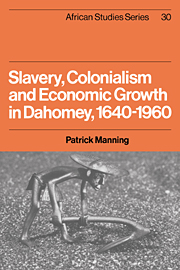Book contents
- Frontmatter
- Contents
- Maps
- Tables
- Figures
- Preface
- 1 Slavery, colonialism and economic growth, 1640–1960
- 2 The Dahomean economy, 1640–1890
- 3 Struggles with the gods: economic life in the 1880s
- 4 Production, 1890–1914
- 5 Demand, 1890–1914
- 6 Exchange, 1890–1914
- 7 The alien state, 1890–1914
- 8 Social struggles for economic ends, 1890–1914
- 9 The mechanism of accumulation
- 10 Capitalism and colonialism, 1915–60
- 11 The Dahomean national movement
- 12 Epilogue
- Notes
- Appendix 1 Export revenue from Dahomey, 1640s–1950s
- Appendix 2 Slave exports by ethnic origin
- Appendix 3 Population loss due to slave exports
- Appendix 4 Foreign trade of Dahomey
- Appendix 5 Foreign trade indices
- Appendix 6 Rainfall
- Appendix 7 Fiscal flows
- Appendix 8 Money supply of colonial Dahomey
- Bibliography
- Index
Appendix 4 - Foreign trade of Dahomey
Published online by Cambridge University Press: 26 October 2009
- Frontmatter
- Contents
- Maps
- Tables
- Figures
- Preface
- 1 Slavery, colonialism and economic growth, 1640–1960
- 2 The Dahomean economy, 1640–1890
- 3 Struggles with the gods: economic life in the 1880s
- 4 Production, 1890–1914
- 5 Demand, 1890–1914
- 6 Exchange, 1890–1914
- 7 The alien state, 1890–1914
- 8 Social struggles for economic ends, 1890–1914
- 9 The mechanism of accumulation
- 10 Capitalism and colonialism, 1915–60
- 11 The Dahomean national movement
- 12 Epilogue
- Notes
- Appendix 1 Export revenue from Dahomey, 1640s–1950s
- Appendix 2 Slave exports by ethnic origin
- Appendix 3 Population loss due to slave exports
- Appendix 4 Foreign trade of Dahomey
- Appendix 5 Foreign trade indices
- Appendix 6 Rainfall
- Appendix 7 Fiscal flows
- Appendix 8 Money supply of colonial Dahomey
- Bibliography
- Index
Summary
The seven tables in this appendix provide a comprehensive summary of the recorded foreign trade of the area of modern Benin from 1863 to 1960. The tables have been set up to display a wide range of goods and to facilitate comparisons over time.
Table A4.1: Lagos exports to Porto-Novo, 1863–1896. Although no records were kept at Porto-Novo until 1884, most of Porto-Novo's trade went through Lagos, where the Blue Books list commercial returns beginning in 1863. In fact, only imports to Porto-Novo from Lagos were recorded in detail, as shown in this table. (For purposes of conversion between this and subsequent tables, £1 sterling was the equivalent of 25 francs until 1914.) Exports of palm products from Porto-Novo via Lagos were reported as Lagos exports: Porto-Novo exports comprised from ten to twenty percent of the reported Lagos total until the end of the century, when Cotonou gained dominance in Porto-Novo's trade. Consular reports, both British and French, contain further data on Bight of Benin trade before 1890.
Table A4.2: Exports by port, 1884–1895. For 1884 and 1887, though not for other years, commercial returns were listed for portions of the Bight of Benin in Statistiques coloniales, published annually by the French Ministry of Colonies. For 1889 through 1895, export statistics listed by port and by quarter are held in Paris at the Archives nationales, Section Outre-mer (Dahomey IX-7), and are also to be found in a bound volume in the Archives nationales du Benin. I have used both sets (there are some discrepancies) to compile the totals by port and by year.
- Type
- Chapter
- Information
- Slavery, Colonialism and Economic Growth in Dahomey, 1640–1960 , pp. 344 - 393Publisher: Cambridge University PressPrint publication year: 1982

